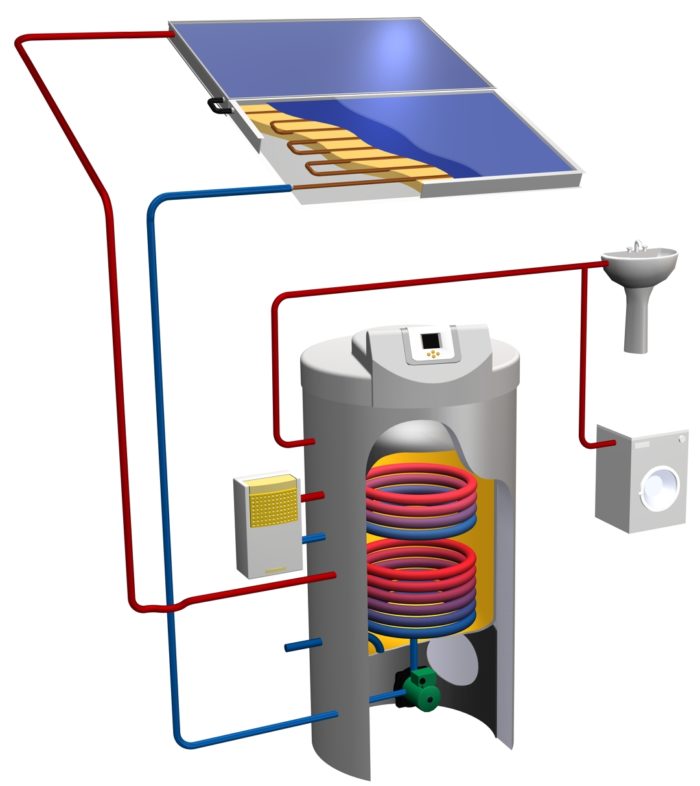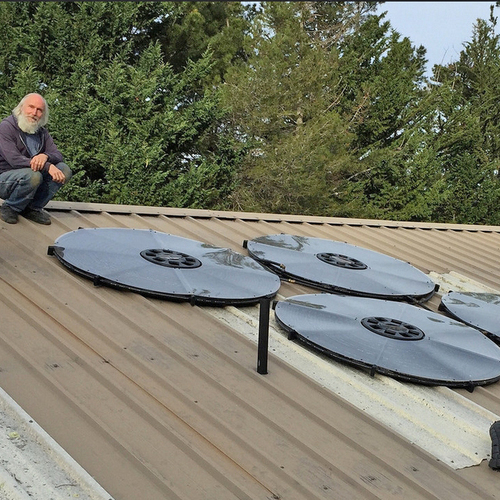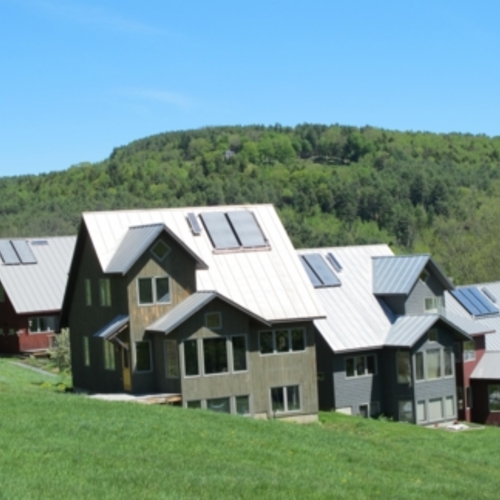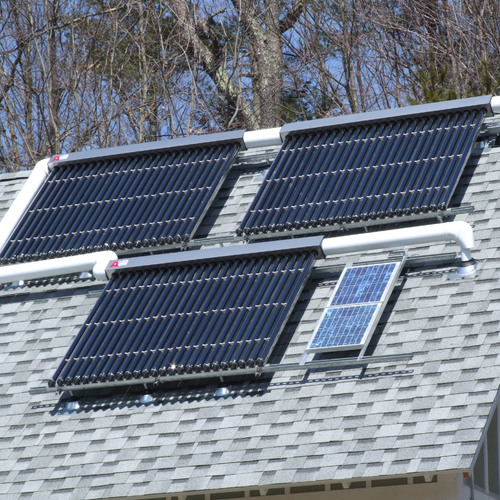Image Credit: Wagner & Company
Image Credit: Wagner & Company Wagner's flat-plate solar collectors are among the world's most efficient, with 96% transmissivity of the glass and a selective absorber surface.
Image Credit: Wagner & Company
I was in Boston last week for the annual Building Energy conference, sponsored by the Northeast Sustainable Energy Association. Each year this conference provides an opportunity to connect with friends and colleagues, catch up on leading-edge building design, and learn about product innovations in energy conservation and renewable energy.
I was amazed to see the large number of European companies represented in the conference trade show, with most of the leading innovation in windows, biomass heating, and solar energy seeming to come from Germany.
Solar hot water systems are often cost-effective
The product that I found most exciting this year was a unique, drainback solar water heating system, SECUSOL, from the German company Wagner & Company, which is one of Germany’s oldest, though not largest, manufacturers of solar water heating systems. Wagner products are represented in the U.S. by Wagner Solar, Inc., of Cambridge, Massachusetts.
Before describing what makes the Wagner SECUSOL so exciting, a few words about solar thermal systems are warranted. Over the past few years, solar electricity (photovoltaics) has garnered most of the attention in the renewable energy world. But solar thermal systems, which can include both solar water heating and solar space heating, are often significantly more cost-effective.
Closed-loop and drainback equipment
Most solar water heaters include flat-plate collectors through which water or a water-glycol mixture is circulated. “Closed-loop” systems have the collector filled all the time, and a pump circulates the fluid from the collectors, where solar heat is absorbed, to the tank, where a heat-exchanger coil transfers that heat to the stored water.
Other systems have an open “drainback” loop. When the sun is shining and the controller tells the pump to turn on, the water or water-glycol solution is pumped through the collectors, and when the sun goes down at night (or power is lost), the fluid in the collectors drains back to a drainback tank. This drainback configuration has the advantage of preventing the collector fluid from getting too hot if the electric pump fails or electricity is lost.
A drainback system with clever features
The Wagner SECUSOL system is the latter type of solar water heater, but with several significant distinctions:
Drainback design without a separate tank. Most drainback systems have a separate tank that has to be plumbed into the system. In the SECUSOL system, an oversized heat-exchanger coil in the storage tank serves as the drainback tank — so one component serves two key functions.
Elegant housing. A single housing contains the well-insulated 66-gallon or 92-gallon storage tank, the controls, and the circulation pump (situated beneath the tank and accessible through a hatch). This configuration means that the single unit, which is not much bigger than a standard water heater, contains everything except the collector(s) and a back-up heating element.
Quick-mount fittings. The plumbing lines that circulate the glycol heat-transfer fluid through the collectors and heat exchanger coils in the tank are pre-insulated flexible copper, and they connect with compression fittings. This avoids the need for soldering, speeds installation, and reduces the risk of installer errors.
Pre-programmed controls. The controls that tell the pump when to turn on and off come pre-programmed, speeding installation.
High-efficiency collectors. The Wagner EURO C20 AR-M flat-plate copper collectors are among the highest efficiency collectors available. They feature extremely high light transmissivity (96%), a selective coating on the absorber plate, and nearly 2-1/2 inches of mineral wool insulation in the back of the collector. They can be installed flush to the roof or on a racking system, which is also made by Wagner.
Back-up heating element. A second heat exchanger in the insulated tank allows a back-up electric heating element to be installed. In this way, the single tank can provide a family’s entire water-heating needs. When solar energy is adequate, the electric element isn’t needed, but when there isn’t enough solar, the family has hot water.
Easy, rapid installation. The various innovations with Wagner’s SECUSOL solar water heating system enable it to be installed rapidly and efficiently. A skilled installer can install two complete systems per day, according to Wagner Solar, which is remarkable. This helps keep the total cost down. Tyler Plante of Wagner Solar, Inc., in Cambridge, told me that systems are typically installed for between $7,500 and $8,000.
Solar thermal systems can also be used for space heating
Wagner also produces some elegant solar space heating systems with packaged components and easy integration with conventional or pellet-fuel heating equipment; more about active solar space heating in a future blog.
Wagner Solar introduced Wagner products to the U.S. market in late 2010 and has installed slightly over 100 systems to date through the East Coast, but mostly in Massachusetts, according to Plante. The company is currently expanding its dealer network.
________________________________________________________________________
Alex is founder of BuildingGreen, Inc. and executive editor of Environmental Building News. To keep up with his latest articles and musings, you can sign up for his Twitter feed.
Weekly Newsletter
Get building science and energy efficiency advice, plus special offers, in your inbox.
















12 Comments
Nice, complete, expensive
Nice, complete system.
Expensive.
The system should cost $3,000 plus install, half day plus costs, total $3,500.
A $3,500 install would sell 100 units a week instead of in 2 years.
And we need it produced locally. Support US manufacturing. and jobs.
Love it - but...
Clever engineering, simple and easy to install. Has everything for one to want one except for it's stratospheric price point. A system with similar performance can be purchase for ~$4500. http://www.thermo-dynamics.com/solar_boiler.html
Sorry, I love the product and would buy one, just not at this price.
re Alex
Is any of the maintenance on a drainback system, or this system specifically, anticipated to be less frequent or less costly than it is for a closed loop (polyglycol) system?
This total engineering and design approach seems to me to be very promising for future growth. I gather you feel the same, or you wouldn't have reviewed it so thoroughly
Thanks
I like the simplicity. The
I like the simplicity. The price? I was quoted the same number for one up here. With shipping, this one would be more, but the simplicity is appealing. Complex solar heating is an oxymoron.
Simple elegant design
It is a shame that the United States is continually outclassed by the Europeans, the Japanese and the Canadians in solar, windows and energy storage to mention but a few. The U.S. companies only seem concerned with one thing, profits. Does not leave much room for innovation. I have been shopping for efficient windows and I can only find one company here that meets the criteria for passive house. Does not seem right.
Simple Drainback
Here's an American system that is even simpler: http://solarheatexchangemanufacturing.com/NewFiles/80galdb.html
The Butler Sun Solar wand design saves money if the homeowners already have a water heater. It uses the existing tank for solar storage, even if it is a conventional gas water heater.
Since there is no tank cost, this is one of the cheapest kits available. http://www.butlersunsolutions.com/solar-water-heating-system/sahw-2c
But none of these systems will be successful against natural gas unless they have an installed price of $2k or less, according to a recent NREL report.
In the meantime, if you have an unshaded south facing wall, we've been testing a super simple thermosyphon system that can break the $2k price barrier:
http://greenbuildingindenver.blogspot.com/2012/02/simplest-solar-system-ever.html
Good Review
Tim,
Great review. There is another company doing simple drainbacks: http://www.solarheatexchangemanufacturing.com/
Also, I'll expect to see other major manufacturers following suit soon. At $7k installed, the SHW is a $123 billion dollar market at current prices. According to SEPA, at current market prices it makes sense for 16% of americans in 72 electric utilitiy areas: http://www.renewableenergyworld.com/rea/blog/post/2012/02/dont-count-out-solar-water-heating-its-a-123-billion-market
The challenge for the industry are largely propert placement in the supply chain, sales + marketing + operational efficiency and training.
Chris
1 website, 2 opposite opinions
Alex writes that solar thermal is "often significantly more cost-effective." than PV. Martin writes that solar thermal is "dead." Did something happen between March 15th and 23rd to kill the industry?
Martin seems to have some better numbers to back up his argument. Alex uses an offhand verbal price quote from a rep at a trade show, and does not reference how much hot water that produces.
I think if we are to claim that they are cost effective, we need to take the analysis a little further. I reference your coworker.
https://www.greenbuildingadvisor.com/blogs/dept/musings/solar-thermal-dead
Response to Malcolm Lewis
Malcolm,
I'll let Alex Wilson respond to your substantive questions.
Concerning the editorial policy at GBA, I just want to say that those who we invite to be published on our pages express diverse opinions. There is no monolithic GBA viewpoint. Our website provides a publishing platform for thoughtful writing on the subject of green residential construction -- but our contributors don't always agree on all matters.
On solar-thermal vs. PV
Martin's blog is thought-provoking, as usual, and a great contribution to an important discussion. I agree with much of it.
When I wrote "solar thermal systems, which can include both solar water heating and solar space heating, are often significantly more cost-effective [than PV]," I was generalizing quite a bit--because I feel that solar thermal deserves to be kept in the mix of renewable energy solutions and that innovations that simplify those systems will keep improving them (as long as we keep pursuing a multi-faceted renewable energy approach).
Interestingly, for my own home--a new house I have planned in Dummerston, Vermont--I am strongly leaning toward skipping a solar hot water system in favor of electric water heating powered by PVs. The beauty of no moving parts is, indeed, compelling.
But I reject that idea that we need to unite around a single renewable energy approach and discard others. We need a mix of technologies and systems to successfully wean ourselves from fossil fuels. In the right situation, solar-thermal should be part of that palette. In the right applications, that mix should include wind, hydro, biomass, solar thermal, and PV. Wind only makes sense at a certain scale and in the right location. Biomass has pollution impacts that need to be addressed, but it is a good option in certain situations. Solar-thermal also has an important role to play, with both utility-scale and smaller solar water heating systems.
Thanks, Alex
Alex,
I agree!
Electric water heater
I'm curious about what type of electric water heater you're thinking of for your new house. I'm probably going to be installing a PV system and am trying to decide what to do about hot water (which is currently off my oil boiler). I've been thinking of some type of electric for the summer then switch back to oil for the winter...but I'm getting dizzy reading up on pros and cons of the different electric options.
Log in or create an account to post a comment.
Sign up Log in